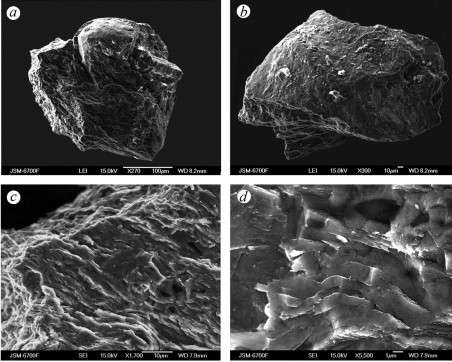SEM images of the Tunguska diamond-lonsdaleite-graphite intergrowths with natural rounded surface. Credit: Planetary and Space Science, http://dx.doi.org/10.1016/j.pss.2013.05.003
(Phys.org) —A team of researchers with members from the U.S., Germany and Ukraine is claiming in a paper they've had published in the journal Planetary and Space Science, that they have found evidence to prove the Tunguska event was caused by a meteor that exploded in the atmosphere above the Russian plain.
The Tunguska event was, of course, an explosion that occurred in a remote part of Siberia in 1908. Most scientists agree that it was caused by either a meteor or comet strike, and as such, was the largest to ever strike our planet in recorded history. The blast flattened thousands of acres of forestland and led to numerous research efforts to determine its cause. Due to the immense power of the blast however, no physical evidence of the source of the blast has ever been found. Now, however, the researchers in this new effort claim they have found proof that some rocks found by a Ukrainian scientist back in 1978 are remnants of the meteor that caused the massive explosion.
The rock samples were found in a bog by Mykola Kovalyukh near the epicenter of the explosion—he claimed at the time that his samples offered proof that the explosion was caused by a meteor. Critics dismissed his claims however, because the rock samples contained too little iridium.
Picking up where Kovalyukh left off, the new team working in the Ukraine used more modern tools to reexamine the stone samples. They claim that transmission electron microscopy has revealed finely veined iron-based minerals that include schreibersite, troilite and taenite, an iron–nickel alloy. They say the patterns and amounts of the materials in the rock samples are very similar to other known meteorite samples and thus, it is a near certainty that the samples found in the bog came from a meteor as well.
Despite the team's claims that they have identified the cosmic body that caused the Tunguska explosion, there is still one big problem—though they may have proved the rock samples they examined are in fact remnants of a meteor, they have no proof that the sample rocks came from the same meteor that caused the massive explosion. Because Kovalyukh didn't collect peat samples from the bog where the rocks were found (to provide a means of dating) there is no way to prove that the sample rocks—meteor remnants—didn't land in the bog sometime after the explosion.
More information: New evidence of meteoritic origin of the Tunguska cosmic body, Planetary and Space Science, dx.doi.org/10.1016/j.pss.2013.05.003
via Nature News
Journal information: Planetary and Space Science
© 2013 Phys.org























